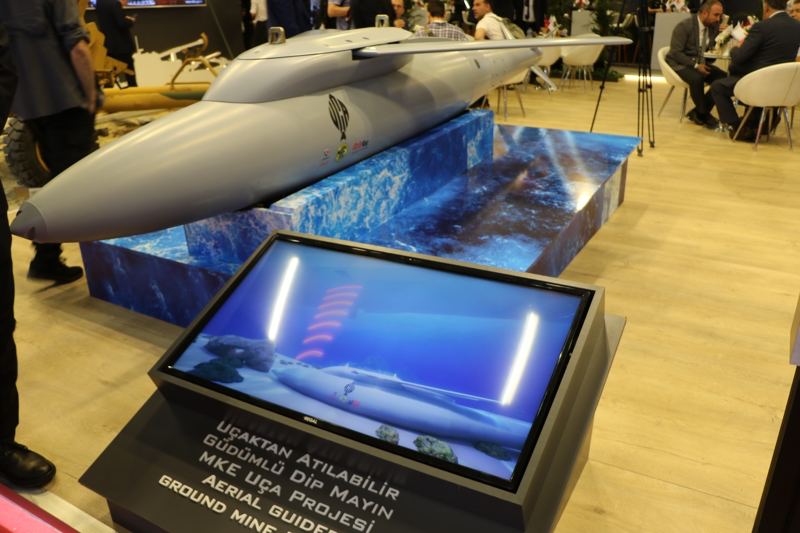Fatih Yurtsever*
The 16th International Defense Industry Fair (IDEF’23), hosted by the Turkish Ministry of Defense, took place at the Tüyap Fair Center in İstanbul from July 25 to 28. Many foreign defense industry companies participated in the fair, showcasing their latest innovations, while leading Turkish defense contractors exhibited their newly developed products. The Russia-Ukraine war, initiated by Russia’s invasion of Ukraine on Feb. 24, 2022, has not only reshaped the geopolitical landscape but also provided concrete examples of how advancing technology affects the nature of warfare, such as the use of unmanned surface vehicles in naval warfare. So how have the lessons learned from the Ukraine-Russia war impacted Turkish defense industry products?
Russia confiscated Ukrainian naval vessels in Crimea in 2014 following the annexation of the territory. Therefore, at the beginning of the war, Ukraine did not have an adequate navy to protect its ports from being blockaded by the Russian navy. Since the Ukrainian navy does not have enough warships or submarines, it has started using unmanned surface vehicles (USVs) or kamikaze USVs to damage the warships of Russia’s Black Sea Fleet and restrict their freedom of operation.
On Aug. 4 a Ukrainian kamikaze USV attacked the Russian Black Sea Fleet’s Ropucha-class landing ship Olenegorsky Gornjak in Novorossiysk. The ship was spotted while being towed by two tugs. Ukrainian sources claim the Olenegorski Gornjak received “a serious breach and is currently unable to perform its combat tasks.”
Ukraine started using kamikaze USVs in the war in the autumn of 2022. The first assault, which occurred on Oct. 29, was shocking for the Russian Black Sea Fleet since it was unexpected. The Ukrainian USV reportedly hit an Admiral Grigorovich-class frigate and a mine countermeasure (MCM) ship during the attack. After the initial attack, Ukraine carried out a number of other attacks on the Sevastopol naval base, the Kerch Bridge and several Russian units in the Black Sea.
Following these attacks, Russia withdrew some of its Black Sea Fleet warships from the Sevastopol naval base and redeployed them to the Novorossiysk naval base. The Olenegorsky Gornyak, attacked by the Ukraine kamikaze USV, was used for logistical supply between the Crimean Peninsula and the Russian mainland. Ukraine’s attack on the Kerch Bridge, which provides transport and resupply links between Crimea and the mainland, and the recent targeting of a landing ship used for resupply between the peninsula and the Russian mainland, show that Ukraine is seeking to disrupt logistical supplies in preparation for an offensive operation to liberate the Crimean Peninsula from Russian occupation.
The Ukrainian navy’s lack of a sufficient number of frigates, corvettes and submarines did not hinder its ability to execute effective attacks on Russian warships and naval bases. Instead, it employed kamikaze USVs as an innovative alternative, highlighting their potential as effective tools in naval warfare. Recognizing this potential, the Turkish navy’s requirements for kamikaze USVs and the export opportunities, Turkish defense contractors initiated a process of product development. They showcased their innovations at IDEF’23, aligning strategically with emerging naval technologies.
Havelsan, a significant player in the Turkish defense industry, unveiled its latest innovative product, the ÇAKA S-KUSV (Submersible Kamikaze Unmanned Surface Vehicle), at IDEF’23. The ÇAKA S-KUSV is a multi-dimensional platform capable of operating both on the surface and underwater. Its unique design allows for stealthy and powerful strikes against surface targets. It is equipped with high-explosive payloads, ensuring a powerful impact on its targets. Its ability to operate underwater adds an element of surprise, allowing it to catch adversaries off-guard and deliver superior strikes. The vehicle also features a mobile/shore control center, providing multiple units with a centralized command and control hub.
Compared to existing naval warfare technologies, the ÇAKA S-KUSV offers unique advantages. Its speed, stealth, endurance and firepower make it a formidable asset in modern and future naval operations. The ÇAKA S-KUSV is also relatively inexpensive, making it an attractive option for countries with limited defense budgets.
Another standout at the fair was UÇA, an innovative bottom mine designed to be launched from various air platforms, including F-16 jets, as well as Akıncı and Aksungur unmanned combat aerial vehicles (UCAVs), from a range of 70 kilometers. Developed by MKE in partnership with TÜBİTAK-SAGE (Defense Industries Research and Development Institute) and Koç Savunma, UÇA represents a new generation of air-launched sea mines.
The system was announced just days before IDEF’2023, showcasing MKE’s transformation of general-purpose Mk-84 bombs into offensive mines. By integrating a guidance kit known as Gökçe (wing-assisted guidance), along with intelligent target detection and a mine-firing unit, UÇA has been engineered to proceed to a predetermined diving location after being dropped from an air asset such as an F-16 fighter jet or large unmanned aircraft like AKINCI and AKSUNGUR. Once positioned at the bottom of the sea, the mine waits for an enemy ship to trigger its warhead, exemplifying modern advancements in naval warfare technology.
For a nation with a less robust navy, employing UCAVs to mine the naval bases and port exits of a country with a superior navy could limit the stronger country’s ability to use its naval power effectively. Turkey’s development of offensive mining capabilities through UCAVs could provide a significant strategic advantage in the Black Sea, particularly against Russia. Should Turkish-Russian relations deteriorate, Turkey might consider selling UÇA to Ukraine or transferring this technology through co-production. This would enable Ukraine to mine Russian port exits and naval bases using F-16 fighter jets, potentially negating Russia’s ability to effectively blockade Ukrainian ports with its Black Sea Fleet.
In conclusion, the Russia-Ukraine war is a blueprint for defense industry companies, guiding them in the types of weapons and sensors they should produce. The innovative products exhibited by Turkish defense contractors at IDEF’23 underscore Turkey’s astute analysis of the Russia-Ukraine conflict and the lessons learned from it.
* Fatih Yurtsever is a former naval officer in the Turkish Armed Forces. He is using a pseudonym out of security concerns.

